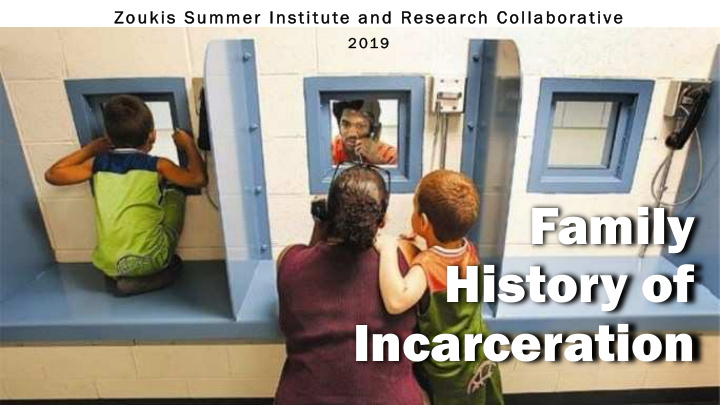



Zo Zouk ukis S is Sum ummer er Inst Instit itut ute a e and nd R Resea esearch C Collabo borativ ive 2 0 2 019 Family History of Incarceration
INCARCERATION & RECIDIVISM FAMILY HISTORY OF INCARCERATION RESEARCH GROUP
REPEAT OFFENDERS • A repeat offender is an individual who has already been convicted for a crime, and who has been caught again for committing the crime and breaking the law for which he had been prosecuted in an earlier case. • Long periods being incarcerated have negative effects on the families of the accused. • Individuals re-enter the penal system based on a variety of factors, but our research focuses on how educational attainment, substance addiction, and household income adversely affect whether an individual is more probable in being a repeat offender.
HYPOPTHESIS H 1 : As household income increases, the probability of being a repeat offender decreases H 2 : As educational attainment increases, the probability of being a repeat offender decreases. H 3 : Incarcerates with a history of addiction are more likely to be repeat offenders.
Coefficient Variables (Standard Error) -0.140** • Predictors of Repeat Offense Educational Attainment (0.067) Among Incarcerated Family Members -0.180 Metropolitan Area • All data was taken from (0.167) Family History of -0.058*** Household Income Incarceration Survey (0.015) (FamHIS). The sample of 0.065 respondents is 1, 975. Homeownership (0.103) • 62% of the sample offended -0.103 once while the other 38% Employment Status (0.064) offended more than once. 1.664*** Incarcerate Addiction History (0.114) ***p ≤ .01; **p ≤ .05; *p ≤ .10
EDUCATIONAL ATTAINMENT • If the relative of the accused has Variables Coefficient attained a higher education, or has a (Standard Error) high school diploma, then the Educational -0.140** Attainment (0.067) probability of the incarcerated relative being a repeat offender is less likely.
HOUSEHOLD INCOME • As household income increases, Variable Coefficient (Standard Error) the probability of a relative being a Household Income -0.058*** repeat offender decreases. (0.015)
DRUG ADDICTION • If the incarcerated family member has struggled with Variable Coefficient addiction in the past, the probability of being a repeat (Standard Error) offender greatly increases. Addiction History 1.664*** (0.114)
PREDICTED PROBABILITIES • Increasing educational attainment from its minimum to maximum value results in a -0.10 probability of recidivism. • Increasing income from its minimum to maximum value results in a -0.22 probability of recidivism. • Incarcerates who have struggled with addiction have a +0.35 probability of recidivism.
The Impact of Undergraduate Students: Kara Nelson, LaJayla Incarceration on Families Parker, Joshua Buffa
• Mass Incarceration • Families Introduction and Background
• Dependent Variable • Percentage of families members who have been incarcerated for at least one night • !(#$$%&#'(% ')& %*(%)&%& +'$#,- #).'/.%/'(%&) Design !(#$$%&#'(% ')& %*(%)&%& +'$#,- $%$1%/2) • Independent Variables • Socioeconomic predictors
Variables Coefficient (Standard Error) Educational Attainment -0.047 (1.352) White -7.159*** (2.281) Predictors of Gender 6.261*** (2.243) Family Household Income -3.807*** (0.994) Incarceration Metropolitan Area -7.423*** (0.773) Household Size -0.310 (0.773) Marital Status 3.261*** (1.567) ***p ≤ . 01; **p ≤ . .05; *p [ ≤ . .10
Percentage of Family Members Incarcerated by Race
Percentage of Family Members Incarcerated by Gender
Percentage of Family Members Incarcerated by Income
Percentage of Family Members Incarcerated by Metropolitan Area
Percentage of Family Members Incarcerated by Marital Status
Discussion • Impact on Marginalized Communities • Limitations of the Data • Where do we from here? • Better Policy • Understanding the Realities of Incarceration
FAMILIES AND INCARCERATION Undergraduates: Meeyabonyui Aneneba, Elice Agostini, Noor Smadi, Chris Valley, Gaia Harper Graduates: Bailey Fairbanks, Kristina LaPlant
FAMILIES AND NARRATIVES: • Background on the effects of incarceration • Collateral Damage • Theory and methods • Data Collection • Coding
Research Question ■ What is the emotional impact of visiting an incarcerated family member? ■ Do different racial groups experience different emotions during visits? ■ Do people experience different emotions when the incarcerated family member is a parent, sibling, or child? ■ Do family members experience different emotions during visits if the incarcerated struggles with addiction or is a repeat offender?
Key Words for Coding Emotional Sentiment: ■ Sadness: sad, sorrow, depression, heartbreaking, awful, terrible, emotionally drained, lonely, hurtful, painful, dehumanizing. ■ Anxiety: embarrassment, discomfort, discouraging, awkwardness, shame, scary, monitored, unpleasant, unsettling, confined/controlled, shocking. ■ Anger: degrading, disgust, resentful, unfair/unjust, frustration.
Bl Black Wh White Hi Hispanic Ot Other Sample characteristics 25.29% (106) 51.78% (217) 15.99% (67) 6.92% (29) N= 419 DEMOGRAPHIC BREAKDOWN:
FAMILY RELATIONS BREAKDOWN: Mo Mother er Fa Father Si Sibling Chi Child ld Pa Partner 19 45 142 136 57 4.53% 10.7% 33.89% 32.45% 13.6%
BLACK FAMILIES
HISPANIC FAMILIES
WHITE FAMILIES
Recommend
More recommend